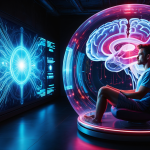The End of Jobs: How AI and Robots Are Reshaping the Workforce
Feb 1, 2025
Humanity at the Crossroads: A Bold Prelude
In a few decades, artificial intelligence (AI) and robotics have transformed from sci-fi tropes into formidable forces reshaping our everyday world—driving cars, conducting surgeries, generating complex simulations, and even penning coherent text. What was once the stuff of futurism is now an imminent shift in how we live and work. The conversation is no longer whether these technologies will replace human labour but how soon and to what extent. Experts once spoke cautiously of incremental automation affecting only repetitive tasks; now, AI grows fast enough to threaten a variety of white-collar professions once thought immune. The unstoppable wave of intelligent machines and advanced algorithms isn’t perched on the horizon; it has already begun to alter the global job market in unpredictable ways.
At first glance, all this triggers primal fear: if machines keep getting “smarter,” do we humans stand any chance of remaining relevant? The tension emerges from the essential question of purpose. When your livelihood, your sense of daily contribution, and often your identity as a worker come under siege from technology that improves every quarter, it’s easy to feel doomed. This emotional upheaval stokes mass anxiety, which in turn births cognitive biases that can hold society back from responding constructively. Yet the path forward need not be a catastrophic meltdown. Indeed, new frontiers of creativity and productivity will open for those who adapt—opportunities unimagined just a generation ago. As the flames of automation burn away rote tasks and the mundane, they can also illuminate new possibilities. Whether we seize them or cower in denial hinges on our collective mindset and willingness to learn from history’s cyclical disruptions.
The Unstoppable March of Automation
Despite ongoing debate, even AI sceptics concede that robots and algorithms have already changed manufacturing, transportation, and customer service beyond recognition. Industrial robots on assembly lines used to be clumsy, expensive lumps of metal. Today, they are sleek, sensor-rich marvels capable of assembling cars at breakneck speed while maintaining near-flawless precision. Self-driving cars are inching ever closer to mainstream adoption, fueled by deep learning technologies that interpret road conditions and driver behaviour faster than even the most alert humans.
Yet the real game-changer is mechanical robotics and the software-driven intelligence behind it. Machine learning models devour data and unearth patterns more swiftly than any human could. Natural Language Processing (NLP) breakthroughs give chatbots the ability to engage in fluid conversations, handle customer service inquiries, and even generate surprisingly creative text. AI now diagnoses medical scans, writes legal briefs, composes music, and orchestrates supply chains with minimal human oversight. The greatest leap forward is in “deep learning,” where layered neural networks mimic aspects of human cognition—yet surpass them in speed and capacity for certain tasks. The moral of this story? Automation doesn’t remain static. Each new iteration refines itself, ironing out errors, branching into new domains, and evolving in ways that defy linear predictions.
Cognitive Traps in the Wake of Rapid Dislocation
In times of radical change, fear can breed paralyzing illusions. As automation sweeps through industries, humans often succumb to “cognitive tunnelling,” wherein stress hones our attention so narrowly that we ignore the broader context. We see the “end of jobs” scenario as a monolithic doomsday, missing the intricate mosaic of emerging roles and opportunities. Another pernicious bias is “confirmation bias,” where we handpick data that supports our gloom or unbridled optimism. One group relentlessly hunts for dire headlines about the robotic takeover, while another group clings to any sign that humans remain indispensable.
This psychological swirl fosters inaction or misguided responses, from ill-conceived government policies that try to freeze technology in place to personal denial that automation is “someone else’s problem.” We sway between extremes, calling for halting AI progress altogether or burying our heads in the sand. Indeed, the mania of mass psychology can drive markets to bubble and burst based on sensational headlines about new “AI breakthroughs.” The true threat often stems from collective paralysis rather than AI itself. If large swaths of society remain stuck in complacency or terror, ignoring the signals to adapt, they’ll be left behind as advanced systems proliferate. Meanwhile, adaptive minds see the unravelling shift not as a doomsday prophecy but as an invitation to pivot, learn, and collaborate alongside machines.
Future Where Machines Do “Almost Everything
Imagine a world where you hail a driverless taxi; automated pickers gather your groceries; your doctor consult involves an AI sidekick that diagnoses conditions accurately, and your chef is a robot from a local automated kitchen. Far-fetched? Hardly. Link the unstoppable momentum of machine intelligence with emergent fields like quantum computing, 5G or 6G connectivity, and advanced robotics, and it’s apparent that human labour is no longer the cheapest or most efficient solution in many spheres. Alongside these developments, white-collar tasks—from reviewing legal documents to generating marketing copy—are increasingly being done by advanced language models, data-crunching software, or specialized AI platforms.
This scenario can indeed feel bleak. If machines do everything, what do humans do for income, purpose, or daily engagement? But this question arises from a reflex that conflates labour with life’s meaning. Millennials and Gen Z are already witnessing the shift: “work” is increasingly distributed, digital, and flexible. When robots and AI take care of the repetitive grind, we can focus on creative tasks, conceptual innovation, emotional intelligence-based roles, and problem-solving that still defy mechanical duplication. The question isn’t whether humans can be replaced. It’s how each person can find synergy with technology to remain relevant, valuable, and personally fulfilled.
Surviving the Shift via Symbiosis
History is riddled with episodes where a groundbreaking technology was initially derided as the end of civilization—only to usher in leaps of prosperity. The Industrial Revolution replaced craftspeople with factories, causing uproar and fear. Yet, over time, societies restructured, new jobs materialized, and overall living standards rose. Of course, the transition was messy; marginalized groups suffered. But forward-thinkers who embraced the new machinery gained a competitive edge. We see parallels between the digital revolution and the dawn of the internet. Entire swaths of jobs vanished—travel agents, video store clerks—but a booming wave of tech careers exploded.
Those same dynamics apply to AI and robots. Astute individuals and organizations that accept the new normal are less likely to be blindsided. They seize AI tools to enhance productivity or pivot skill sets to complementary niches—for example, training robots, designing user-friendly automation interfaces, or analyzing the ethical and social ramifications that complex algorithms pose. Smart money invests in “intangible” skills: creative thinking, empathy, strategic decision-making, and dynamic problem-solving. The ultimate winners adopt a “symbiotic” mindset: letting AI handle the grunt work. At the same time, humans do the high-level interpretation, context-based judgments, and interpersonal relationship building that machines still can’t replicate to the same extent. Essentially, it’s about building a partnership with automation rather than rejecting or passively obeying it.
Mass Psychology 2.0: The New Norm
As AI weaves itself deeper into daily life, mass psychology simultaneously warps. On the one hand, pockets of outright rejection or rebellion against “super-machines” may form, fueled by a nostalgic longing for a simpler era. On the other, entire communities may rush to worship AI, investing it in near-mythic status. Neither extreme is helpful. Balanced adaptation requires acknowledging that these systems excel at certain tasks far better than humans but still struggle with real-world nuance, moral dilemmas, and unstructured creativity. The second we treat AI as infallible gods, we risk ceding essential autonomy—imagine a future where algorithms decide everything from policing to hiring, unchecked. Conversely, if we demonize AI entirely, we remain stuck in a rear-view mirror world, losing opportunities for growth, efficiency, and equality.
Cognitive biases like groupthink exacerbate these extremes. If a subset of thought leaders or online influencers tout AI mania or AI paranoia, the rest follow in echo-chamber logic. Cognitive tunnelling emerges as individuals become so fixated on a chosen stance—utopian or apocalyptic—that they ignore contradictory evidence. This polarizing environment poses threats: ill-informed governance, abrupt economic swings, or misguided public policies. Paradoxically, the best safeguard is the same approach that fosters market success—continuous reflection, data-driven adjustments, and an agile blend of human introspection and objective analysis.
The Upside: Efficiency, Transparency, and Equality
Dystopian visions of mass unemployment overshadow a more optimistic narrative in which advanced automation can reduce corruption, streamline bureaucracy, and democratize resource access. AI, by design, cannot be swayed by bribes or nepotism unless intentionally tampered with. For instance, using blockchain ledgers combined with AI review systems, public funding can be allocated accurately with minimal risk of human manipulation. In developing countries, advanced robotics can handle labour-intensive tasks in agriculture or infrastructure. Freed from backbreaking routines, local populations may focus on education, entrepreneurship, or creative ventures. If orchestrated properly, this shift might even reduce the stark wealth gaps that plague the world. Automation can slash operational costs, transferring savings to end consumers and employees—provided the frameworks for equitable distribution exist.
Of course, realizing this utopia means ensuring governance structures hold technology firms accountable. Wealth disparity could spike if a few corporations monopolize AI tools and robot fleets. But it doesn’t have to play out that way. Governments, open-source platforms, and private innovators can collaborate to expand access to AI resources. Equipping everyday people with powerful, user-friendly co-pilot applications fosters new waves of micro-entrepreneurs, free agents, and creative innovators. Freed from grunt labour, people can build side businesses or solve localized problems, ironically fueling a broader sense of empowerment rather than joblessness.
Skills for the New Era: Hard and Soft
To escape obsolescence (and the dreaded scenario of permanent irrelevance), individuals must develop a new portfolio of capabilities. On the “hard” skills side, data literacy and understanding of AI tools become essential. You don’t necessarily need to code advanced neural networks, but you should know enough about how they function to use them effectively and interpret their outputs. Just as personal computing skills became basic job requirements in the 1990s, AI fluency might be similarly fundamental now.
In parallel, “soft” skills take on greater importance. Emotional intelligence, complex communication, ethical reasoning, and creativity—these are the capacities that machines still struggle to emulate. An AI can’t replicate that empathy and nuance if you’re facilitating a cross-cultural business negotiation or persuading stakeholders about subtle moral issues. The synergy emerges when you combine these strengths with AI’s computational prowess. For example, in healthcare, robots might handle surgeries with millimetre-level precision, while a human surgeon provides final oversight, ensuring that unique patient factors get integrated into the plan. In cybersecurity, an AI algorithm might flag suspicious patterns. However, a human analyst has the final say on escalating an alert, factoring in intangible contextual details the model can’t parse. These forms of human-AI collaboration will define the new generation of skill demand.
Cognitive Tunneling: Avoiding Self-Limiting Blind Spots
Ironically, our biggest threat might be our mental blinders as technology accelerates. Cognitive tunnelling narrows our awareness, fueling illusions that the future is set in stone—guaranteed dystopia or utopia. Historical precedents warn that technology’s outcomes are shaped by the societies adopting it. The printing press democratized knowledge but also incited religious schisms; nuclear power could generate electricity or mass destruction. AI’s potential is similarly ambivalent. The best strategy is maintaining vigilant openness, acknowledging that machine learning can revolutionize healthcare or education while staying alert to risk factors like algorithmic bias, job displacement, and privacy invasion.
Astute players harness the momentum where it’s beneficial, forging new industries, legislation, or social norms that ensure humans remain in the driver’s seat. They do not bury their heads in the illusions that everything is preordained. Indeed, we shape technology at least as much as it shapes us. Encouraging transparent design, stakeholder collaboration, and robust testing can mitigate harmful side effects. The antidote to cognitive tunnelling is an agile adaptation in real time. Rather than fixating on static convictions, we recalibrate as events evolve, personally (learning advanced AI tools and re-skilling) and collectively (updating regulations, ethical standards, and education curricula).
Imagining a Better Tomorrow
Let’s fast-forward a century into a world where AI is integral to governance, resource management, and daily life. Perhaps everything from traffic to public health is optimized by algorithms that manage supply chains, reduce accidents, and preempt disease outbreaks. Freed from the daily slog, humans pivot to more creative, interpersonal endeavors—expanding the arts, diving deeper into philosophical questions, forging cross-cultural collaborations. Indeed, an advanced robot workforce might reduce corruption by automating bureaucratic tasks, verifying data for authenticity, and conferring transparent, data-driven decisions. We might see a universal baseline of income and services derived from the efficiency gains of automation, narrowing the wealth chasm. With fewer tasks to squabble over, political warfare could recede. Freed from the zero-sum struggle for resources, societies might re-centre on well-being, innovation, and personal growth.
That’s the optimistic arc. Humanity’s track record is one of cyclical leaps from times of harsh upheaval to new forms of structured prosperity. The “end of jobs” is not necessarily the end of purpose—it might be a rebirth of how we define productivity, collaboration, and contribution. AI and robots might do “almost everything,” but humans still provide the intangible soul, forging meaning beyond mechanical function. Whether we realize this elegantly or stumble chaotically is up to us. Our best bet is to approach the unstoppable wave of automation with rational humility, ethical vigilance, and an eager willingness to learn. If we adapt well, the future can dazzle us with abundance, creativity, and a newly scoped sense of what it means to be alive in a world where the old definition of “job” is obsolete. The stage is set for rediscovering human potential—should we dare to seize it.















